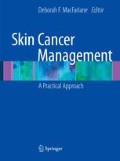Abstract
In general terms, photodynamic therapy (PDT) involves the use of a light source to activate a compound (photosensitizer) within malignant cells. The activated compound then transfers its energy to molecular oxygen, which works in a destructive capacity to eliminate the tumor.1
Access this chapter
Tax calculation will be finalised at checkout
Purchases are for personal use only
References
Marcus SL, McIntyre WR. Photodynamic Therapy systems and applications. Expert Opin Emerg Drugs. 2002;7:331–334.
Tierney EP, Eide MJ, Jacobsen G, Ozog D. Photodynamic therapy for actinic keratoses: survey of patient perceptions of treatment satisfaction and outcomes. J Cosmet Laser Ther. 2008;10:81–86.
Kaufmann R, Spelman L, Weightman W, Reifenberger J, Szeimies RM, Verhaeghe E, et al. Multicentre intraindividual randomized trial of topical methyl aminolaevulinate-photodynamic therapy vs. cryotherapy for multiple actinic keratoses on the extremities. Br J Dermatol. 2008;158:994–999.
Surrenti T, De Angelis L, Di Cesare A, Fargnoli MC, Peris K. Efficacy of photodynamic therapy with methyl aminolevulinate in the treatment of superficial and nodular basal cell carcinoma: an open-label trial. Eur J Dermatol. 2007;17:412–415.
Levulan Kerastick. FDA Label (NDA 020-965). 2003. http://www.fda.gov/cder/foi/label/1999/20965lbl.pdf. Last accessed February 3, 2009.
Ehrig T, Cockerell C, Piacquadio D, Dromgoole S. Actinic keratoses and the incidence of occult squamous cell carcinoma: a clinical-histopathologic correlation. Dermatol Surg. 2006;32:1261–1265.
METVIXIA (methyl aminolevulinate) Cream, 16.8%. FDA Label. 2007.
Smith S, Piacquadio D, Morhenn V, Atkin D, Fitzpatrick R. Short incubation PDT versus 5-FU in treating actinic keratoses. JDD. 2003;2:629–635.
Alexiades-Armenakas M, Geronemus R. Laser-mediated photodynamic therapy of actinic cheilitis. J Drugs Dermatol. 2004;3:548–551.
Ruiz-Rodriguez R, Sanz-Sanchez T, Cordoba S. Photodynamic Photorejuvenation. Dermatol Surg. 2002;28:742–744.
Karrer S, Baumler W, Abels C. Long-Pulse Dye Laser for Photodynamic therapy: Investigations in Vitro and in Vivo. Lasers Surg Med. 1999;25:51–59.
Morton C, Campbell S, Gurg G. Intraindividual right-left comparison of topical methyl aminolaevulinate-photodynamic therapy and cryotherapy in subjects with actinic keratoses: a multicentre, randomized controlled study. Br J Dermatol. 2006;155:1029–1036.
United Kingdom Summary of Product Characteristics. 2007. http://www.medicines.org.uk/. Last accessed 1/20/09.
Australia Summary of Product Characteristics. 2007. Australian Regulatory Guidelines for OTC Medicines. http://www.tga.gov.au/docs/html/argom.htm. Last accessed 1/20/09.
Horn M, Wolf P, Wulf HC, Warloe T, Fritsch C, Rhodes LE, et al. Topical methyl aminolaevulinate photodynamic therapy in patients with basal cell carcinoma prone to complications and poor cosmetic outcome with conventional treatment. Br J Dermatol. 2003;149:1242–1249.
Rhodes LE, de Rie MA, Leifsdottir R, Yu RC, Bachmann I, Goulden V, et al. Five-year follow-up of a randomized, prospective trial of topical methyl aminolevulinate photodynamic therapy vs surgery for nodular basal cell carcinoma. Arch Dermatol. 2007;143:1131–1136.
Acknowledgements
The authors are sincerely grateful to Anne Paquette, RN, BSN, CCRC, and Michelle McCarthy, RPA-C, for their assistance in preparing this manuscript.
Author information
Authors and Affiliations
Editor information
Editors and Affiliations
Rights and permissions
Copyright information
© 2009 Springer Science+Business Media, LLC
About this chapter
Cite this chapter
Zeitouni, N.C., Oseroff, A., Najarian, D.J. (2009). Photodynamic Therapy. In: MacFarlane, D.F. (eds) Skin Cancer Management. Springer, New York, NY. https://doi.org/10.1007/978-0-387-88495-0_4
Download citation
DOI: https://doi.org/10.1007/978-0-387-88495-0_4
Published:
Publisher Name: Springer, New York, NY
Print ISBN: 978-0-387-88494-3
Online ISBN: 978-0-387-88495-0
eBook Packages: MedicineMedicine (R0)

